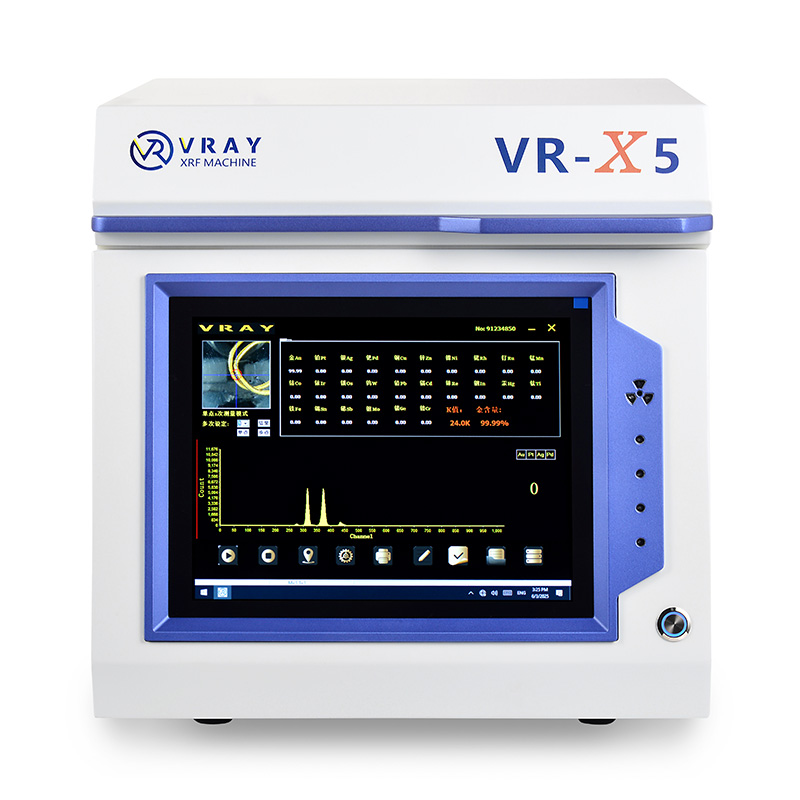Welcome to www.vraygoldtester.com, When it comes to gold purity testing, precision is paramount, especially for industries like jewelry, finance, and manufacturing. Among the many tools used for this task, the XRF (X-ray fluorescence) gold tester is one of the most widely used devices. But just how accurate is its gold purity testing? This article will delve into the accuracy of XRF gold testers and analyze the key factors that influence their reliability.
An XRF gold tester utilizes X-ray fluorescence (XRF) technology, a non-destructive analytical method used to precisely determine the elemental composition of metal samples. The core working principle is as follows: the device's X-ray tube emits high-energy X-rays that irradiate the gold sample. This process excites the atoms within the sample, causing them to emit secondary X-rays with unique energy levels.
These secondary X-rays are captured by the device's built-in high-resolution detector and then analyzed by a processor and software system. By measuring the energy levels and intensity of different elements, the system can quickly and accurately identify the sample's elemental makeup (e.g., gold, silver, copper, nickel) and their respective percentages. This allows for a precise calculation of the gold's purity (e.g., in karats). With its fast, non-destructive, and highly reliable characteristics, this technology has become the preferred tool for gold purity testing in the jewelry, recycling, and manufacturing industries.

The accuracy of an XRF Gold Tester depends on several factors, including the model of the tester, the quality of the sample, and calibration. At VRAY Instrument, The VR-T5, VR-T6, and the VR-T7 XRF analyzers are High-end models, often used in the precious metals industry, can achieve an accuracy level as high as 0.01%.
XRF gold testers are especially accurate for higher-karat gold (such as 22K or 24K), where there is less variation in the alloy composition. For lower-karat gold or items that contain mixed metals, there may be slight variances in readings, but modern XRF testers are calibrated to minimize these discrepancies.
The condition of the gold sample being tested plays a significant role in accuracy. For example, if the surface is dirty or oxidized, the readings might be affected. Some XRF analyzers are equipped with features to adjust for this, but proper sample preparation—such as cleaning the surface—can enhance accuracy.
An XRF gold tester requires periodic calibration using reference standards to maintain precision. This ensures that the readings are consistent and reliable. At VRAY Instrument Limited, Most modern XRF gold testers, such as the VR-X3 or VR-X5, come with pre-calibrated software that auto-adjusts to the sample type, ensuring minimal human error.
Another aspect that influences accuracy is the detection limit of the XRF gold tester. Models with advanced detectors, like the VR-T7 with a Fast-SDD detector, can detect even trace amounts of elements, making them highly precise. However, the presence of elements in very small quantities can sometimes challenge even the best detectors, though this typically only affects extremely low concentration readings.
XRF gold tester measure the composition of the surface layer of the material. For gold-plated items or jewelry with coatings, the results will reflect only the surface composition. To mitigate this, some models like the VR-XAU coating thickness analyzer can measure both the surface coating and the underlying material, providing a more accurate assessment of the overall composition.
In real-world applications, the accuracy of most XRF gold testers is sufficient for the vast majority of commercial and industrial needs. Jewelers, pawn shops, and gold refineries all rely on them to verify gold purity, and the results are considered a reliable basis for value assessment in trade and investment.
To better visualize the practical accuracy of XRF gold testers, the following table demonstrates the technological advancements of the past decade:
| Technology Phase | Testing Accuracy (Gold Purity) | Time Required |
| Ten Years Ago | ±0.5% to ±1% | Approx. 30-60 seconds |
| Today | ±0.03% to ±0.1% | Approx. 5-15 seconds |
In conclusion, XRF gold testers have become one of the most accurate and reliable tools for gold analysis on the market, thanks to their non-destructive, fast, and precise testing capabilities. While the accuracy of any gold tester depends on several factors, including sample preparation, calibration, and the model of the tester, modern XRF analyzers are capable of delivering highly reliable results, ensuring confidence in the gold testing process.
If you are looking for a high-performance gold tester, VRAY instrument Limited is your ideal choice, offering a perfect balance of speed, precision, and ease of use. We firmly believe that combining VRAY's professional technology with your business strengths will lead to a win-win partnership. Contact the VRAY professional team today to embark on a new chapter of precise analysis together!